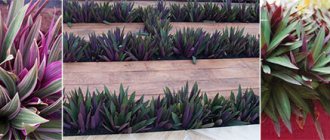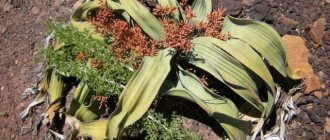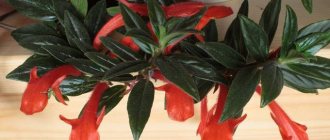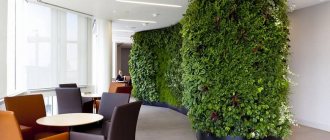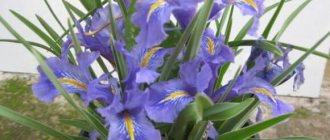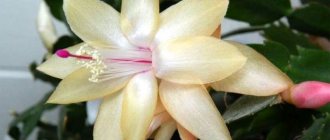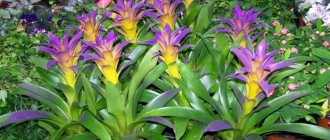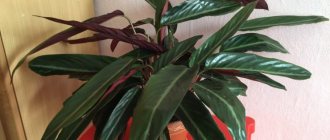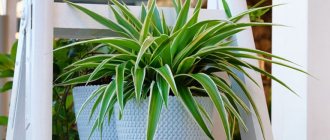Nowadays, plants of unusual colors, especially red, are gaining popularity, and we are not talking about the color of the flowers themselves. Plants with red leaves look fresh, bright, beautiful, interesting, they can charm at first sight and decorate any room. By the way, the red color appears due to anthocyanin pigments. There are a lot of ideas on how to decorate your home or work space with such plants! You can make a green corner by immediately combining different crops with green and red foliage, or create a simpler composition, or you can simply put one bright specimen in a prominent place.
Poinsettia
The beautiful poinsettia is also called Euphorbia most beautiful, Christmas star. A bright representative of the Euphorbiaceae. The most beautiful euphorbia is loved for its unpretentiousness and longevity - it is literally capable of delighting with its beauty for many years, requiring in return minimal but regular care.
Conditions for growing beautiful milkweed:
- Temperature: in summer about +20-25°C, in winter - about +16.
- Lighting: full, a south or south-east window is suitable.
- Watering: moderate, about 2 times in 7 days, in cold weather - 1 time in 3-4 weeks.
- Air humidity: normal, spraying with water is welcome, poinsettia can withstand dry air, but it has a bad effect on decorativeness.
- Pests: scale insects, spider mites, thrips.
- Reproduction: by apical stem cuttings.
Alternanthera
These spreading bushes (about 20 cm high) with oblong-spatulate variegated leaves will also fit perfectly into any flower garden. Alternanthera has many garden forms that differ in leaf color, but most varieties are dominated by green, red and pink shades.
Alternanthera red
Alternanthera sessile
Alternanthera looks best when grown in a sunny area with poor but well-drained soil. Like coleus, plants are transplanted into containers and kept indoors for the winter. In June, the bushes are planted again in open ground and watered moderately.
Caladium
Thanks to its leaves, caladium looks more like some kind of extraterrestrial plant. It is distinguished by a combination of interesting colors and colorful veins.
Conditions for keeping and caring for caladium:
- Temperature: in summer - 20-25, in winter - 15-19.
- Lighting: grown in bright places that are protected from direct sunlight, comfortable on an east or north-west window.
- Watering: moderate, when adding moisture, do not allow water to get on the leaves, stops in winter.
- Humidity: high, regular spraying of the soil surface is recommended.
- Reproduction: daughter tubers.
- Pests: aphids, mealybugs.
- Feature of the culture: in the fall the leaves begin to die and in the winter the caladium is dormant.
Possible difficulties and diseases
Guzmania is easy to grow because it tolerates even unfavorable conditions. However, this plant also has its risks:
- The main pests that can affect Guzmania are: spider mites, scale insects. If parasites are found, wipe the leaves with soapy water, and if the infestation is severe, use insecticides.
- Regular waterlogging can lead to rotting of the root system.
- The plant may become infected with a fungus , as indicated by gray spots on the leaves. To get rid of it, you will need a fungicide.
The fungus began its destructive work from below.
Aglaonema
The evergreen exotic is a member of the Araceae or Aronicaceae family. Grows well in regular substrate and hydroponics.
Conditions for aglaonema:
- Temperature: in the warm period - 20-25 degrees, in the cold - 16-18, but not lower.
- Lighting: full, but diffuse, south-west or south-east windows are suitable.
- Watering: plentiful in the summer, reduced later, but you need to make sure that the soil in the pot never completely dries out.
- Humidity: high, requires spraying with warm water.
- Reproduction: seeds, apical cuttings, suckers, dividing the bush.
- Pests: spider mites, mealybugs.
Contender #3 – elegant southern scumpia
Mackerel grows naturally in regions with a fairly warm climate - in the Crimea, the Caucasus, southern Russia, and on the Mediterranean coast. With the onset of autumn, the leaves of this tall shrub turn burgundy, orange or purple (the color depends on the variety of mackerel). First, the veins turn red, and then the leaf turns bright color.
Mackerel has very beautiful leaves and inflorescences in the form of pink fluffy panicles, which can be used to create various compositions
In central Russia, mackerel has taken root well and is widely used as an ornamental plant. It is good in both single and group plantings and forms luxurious hedges. The shrub loves sunny meadows, protected from the wind. Mackerel is hardy, disease resistant, and pests rarely attack this shrub. Decorative qualities can be enhanced by starting to form a bush.
Our most common varieties of scumpia are:
- Flame;
- Purpureus;
- Grace.
Royal Purper is popular in Europe, but may freeze in colder climates.
If you have slopes or rocky soils on your site, the mackerel will take root well on them and will decorate your garden at any time of the year. In addition to the beautiful color of the foliage in autumn, it is beautiful during flowering - the inflorescences form pink fluffy panicles, making the shrub elegant and attractive.
A hedge of flowering mackerel with lilac leaves is a decoration for the site and a way to hide unsightly buildings
If you decide to decorate your garden with mackerel, keep in mind that it grows well, so it needs space. A small seedling will eventually become a luxurious spreading bush or small tree.
Cordilina
Cordyline leaves are highly decorative. Representative of the Sparzhevs. The crop can be grown in soil or hydroponically.
Features of growing Cordyline:
- Temperature: in summer - 20-25 degrees, in cold weather - not lower than 18, should be protected from drafts.
- Lighting: A bright place is suitable for variegated cordylines, but direct sunlight should be completely excluded.
- Watering: in summer, moisture should be added abundantly, avoiding drying out or waterlogging of the earthen clod; later they are reduced, but you should also not allow the soil to dry out.
- Air humidity: high, regular spraying is recommended.
- Reproduction: through seeds, division of rhizomes, cuttings.
- Pests: aphids, thrips, scale insects.
Coleus
Coleus has two strong advantages: firstly, it is unpretentious, and secondly, it is very colorful and beautiful. Many of them have interesting colors - green borders around the edges and a mottled middle. Representative of the Lamiaceae (or Lamiaceae).
In order for Coleus to please its beauty, it is necessary to satisfy its requirements:
- Temperature: in summer +18-20°C, in winter +12-14, not lower.
- Lighting: for maximum decorativeness, the crop requires full lighting, but direct exposure to rays should not be allowed, the light must be diffused.
- Watering: in spring and summer, abundantly when the top layer of soil in the pot dries, in the cold period it is reduced, but the soil should not be allowed to dry out.
- Air humidity: high, spraying will be beneficial.
- Pests: whitefly, spider mites, aphids.
- Reproduction: cuttings, less often seeds.
Oxalis (Oxalis)
Oxalis, oxalis, lucky clover, sour clover, hare cabbage - these are different names for the same plant. By the way, such names were chosen for a reason; the leaves of the representative of the Kislichny family are really sour. Flower growers are very fond of this crop for its colorful and delicate leaves that resemble butterflies. Oxalis is exactly the case when not only the color, but also the shape of the leaves causes admiration.
Some nuances that are important to know for successfully growing sorrel at home:
- Temperature: in summer 20-25, in winter - 16-18.
- Lighting: bright, but always diffused; direct rays can cause burns.
- Watering: plentiful, but the drainage system must be of very high quality, excess moisture is critical for it, during cold periods the amount of water decreases, you just need to maintain light moisture in the substrate.
- Humidity: moderate to slightly higher than normal room humidity.
- Pests: scale insects, aphids.
- Reproduction: by nodules or daughter bulbs.
Lively Burgundy Glow
This culture rightly evokes the admiration of many gardeners, as it has unusual leaves. Their color changes as they grow older: in a young plant they are red-violet, with a white edge, and over time they become dark burgundy. The tenacious plant also produces small blue and purple flowers.
The plant, which creeps along the ground, takes root easily and feels great in the shade; it also suppresses weeds and will be useful to any housewife. The tenacious plant easily tolerates heat and poor soil, and retains its beauty and bright foliage until the very end of the season.
Nidularium
Attractive because of its glossy, shiny, dense leaves. The highlight of nidularium is given by the bracts, colored red. Refers to Bromeliads.
The following conditions are suitable for decorative deciduous plants:
- Temperature: in warm weather +20-24°C, in cold weather +18-20.
- Lighting: partial shade, strong shadow and direct sunlight are not allowed.
- Watering: moderate, waterlogging should not be allowed; moisture should be added when the soil dries out. In spring and summer, it is recommended to add moisture through the leaf funnel, and in the cold period - in the standard way.
- Humidity: normal room humidity, in dry air you need to spray the leaves.
- Pests: scale insects, mealybugs.
- Reproduction: daughter rosettes.
Croton (Codiaeum)
Croton has attractive leaves. The codiaum flower is not particularly decorative; it is often simply torn off so that it does not take away excess energy. A representative of the Euphorbiaceae family has a truly fantastic color, combining several colors at once: red, yellow, green, pink, orange. This amazing combination will appeal to lovers of picturesque and rich colors. Codiaum also has an interesting feature - milky sap in the stems and leaves.
However, croton is demanding in care; it cannot be called unpretentious and unpretentious:
- Temperature: in summer +20-23, in winter +17-18, t should not fall below 17 degrees. It is also important to avoid any drafts.
- Watering: abundant in spring and summer, perform the procedure when the top layer of soil dries 1 centimeter. In winter, the introduction of moisture is reduced.
- Air humidity: high, it is necessary to regularly spray the leaves and clean them of dust.
- Lighting: should be full, but should be protected from direct rays. Therefore, it is better to place the pot on the east or west side.
- Pests: rarely affect due to the poisonous sap, but under unfavorable conditions (dry air) scale insects are possible.
- Reproduction: apical cuttings, air layering.
Contender #1 – bright, handsome barberry
Barberry is one of the most common shrubs for garden decoration. This is not surprising, since it is unpretentious and has wonderful decorative qualities.
Some varieties of this shrub have an unusual leaf color - burgundy (Thunberg barberry), while others turn bright red with the arrival of autumn. Ottawa barberry Auricoma is a shrub with purple-red leaves that turn red-orange in the fall.
Varieties of Thunberg barberry with green leaf edges. You can plant different types of shrubs on your site, in this case your garden will retain the beauty and brightness of colors until frost
Thanks to its excellent decorative properties, barberry is good everywhere - in single plantings, in groups with other plants and as a hedge. Shrubs don't need to be trimmed, but shaping and trimming them will make them look neater, especially in hedges.
A hedge of barberry bushes looks great against the backdrop of a lawn and gravel path, its maintenance is minimal, and the garden looks beautiful and neat
Barberry Thunberg and Ottawa are the most common. Conifers - Cossack juniper, thuja, pine - will be excellent “companions” for these shrubs. Barberry will form wonderful compositions in the fall in company with yellow deciduous shrubs.
Dwarf barberry seems to be created for miniature compositions - on the lawn, in a rocky garden, to create a mixborder or border. When planting a composition of several shrubs, it is desirable that the variety of forms be visible from everywhere.
When the barberry berries ripen, the foliage turns red and the bush looks doubly attractive, especially on a bright green lawn
Barberry is now sold in garden centers, so if you have chosen this pretty ornamental shrub, you can buy it without any problems.
The role of shrubs in the garden should not be underestimated. They make the garden look lived-in and cozy. Shrubs smooth out sharp edges well, and their beautiful leaves do not require constant care.
Irezine
The compact bush amazes with its lush and colorful beauty. The variegated leaves are painted in an attractive beet red color.
Features of growing irezine at home:
- Temperature: in the warm period - 19-25 degrees, in the cold - 15-18.
- Lighting: the light-loving crop prefers full lighting; on a south window it is recommended to make it diffused.
- Watering: abundant (when the top layer of the substrate dries out), reduced in winter, but do not allow the soil to dry out.
- Humidity: normal, periodic spraying will be beneficial.
- Pests: aphids, whiteflies.
- Reproduction: stem cuttings.
- Feature of caring for irezine: you should periodically pinch the tops of the shoots to form a beautiful bush.
Neoregelia
It is similar to Nidularium, but this is not surprising, because they belong to the Bromeliads. Neoregelia is attractive because of its beautiful glossy leaves and variegated bracts.
The conditions acceptable for neoregelia are simple:
- Temperature range: in summer +21-25°C, in winter - +16-18. It is very important that there is good ventilation and neoregelia has access to fresh air, but it should be protected from drafts.
- Lighting: bright diffused light without direct light.
- Watering: you need to pour water into the rosette of leaves, in winter - under the root.
- Humidity: high, it is recommended to use a humidifier or spray frequently. It is also important to remove dust from the surface of the leaves.
- Pests: aphids, mealybugs, bromeliad scale insects.
- Reproduction: daughter rosettes.
Heuchera Grape Soda
A spectacular fast-growing plant will be an excellent decoration for a flower bed or flower garden; it is also convenient to form borders from. Heuchera looks especially beautiful near a pond, next to hosts, irises, and ornamental grasses. It winters well in temperate climates and feels great under the canopy of trees and shrubs.
The velvety foliage of the flower is constantly changing: in the spring it is dark pink, in the summer it is pink-violet, in the fall it is violet-silver. To maintain its brightness, plant the plant in partial shade, water moderately and drain the soil periodically
Cryptanthus
Cryptanthus is another striking representative of the Bromeliad family. The color of the leaves will appeal to lovers of unusual color combinations. The pattern also looks interesting.
The nuances of growing cryptanthus:
- Temperature: in summer 21-24 degrees, in winter 18-20, without drafts.
- Lighting: loves sunny, bright areas in the house, but without direct sunlight, very light partial shade is allowed.
- Watering: in spring and summer it is necessary to constantly maintain moderate soil moisture. It is important to avoid excess and lack of moisture. The main thing is stability, without sudden changes. In cold weather, the procedure is performed much less frequently; after the top layer of soil has dried, moisture should be added the next day. Water at the root, do not bring water into the outlet.
- Humidity: Cryptanthus needs high air humidity, which must be maintained constantly. An air humidifier or spraying several times every day will help.
- Pests: spider mites, thrips.
- Reproduction: by lateral shoots.
Maranta
An attractive feature of arrowroot is its bright red veins. The combination of scarlet, dark green and light green shades makes this decorative foliage plant stand out. Belongs to the Marantaceae family.
Conditions for growing tropical exotics:
- Temperature: in spring and summer +22-24, in winter and autumn +18-20. Protection from any drafts is important.
- Lighting: bright, but diffused light, but can withstand slight shading.
- Watering: during the warm period, plentiful, it is necessary to maintain moderate soil moisture, and the soil surface should not be allowed to dry out. In winter, the procedure should be performed less frequently; the surface of the top layer of soil should dry out.
- Humidity: high, it is necessary to regularly spray the arrowroot, and it is also useful to periodically clean it in the shower.
- Pests: spider mites.
- Reproduction: by dividing the bush, apical cuttings.
Contender #5 – red-leaved plum (cherry plum)
Red-leaved plum is another unpretentious tree that can be successfully used in garden landscape design. It has dark burgundy leaves and fruits of the same color. The tree also bears fruit well. The red-leaved plum lends itself well to shaping - you can form a spherical crown, it is good both as a free-growing tree and as a hedge. The height of the hedge can be any - from quite high (2 m and above) to 60-70 centimeters. Such a hedge can be an excellent decoration and hide your area from prying eyes. Like the ornamental apple tree, the plum tree is resistant to diseases and pests.
If you want to create a truly original garden on your property and are fond of ornamental plants, be sure to pay attention to red-leaved trees and shrubs. Both in summer and autumn they will help you place the right accents in the garden and create wonderful compositions. The area will look brighter and more elegant at any time of the year, with the exception of winter cold. And fruit plants with decorative foliage - plum, apple tree, barberry - will also delight you with delicious fruits by autumn.
- Author: sunflower12
Rate this article:
- 5
- 4
- 3
- 2
- 1
(20 votes, average: 4.2 out of 5)
Share with your friends!
Begonia royal
The plant is also called Begonia Rex. It blooms rather inconspicuously, so flowering cannot be called the main trump card of a representative of the Begoniev family. The main beauty of the royal begonia is its variegated and luxurious leaves.
- Temperature: about 19-22 degrees, in winter - about 16.
- Lighting: bright, but the sunlight must be diffused; direct rays can cause burns to the foliage.
- Watering: abundant, you need to add moisture immediately when the top layer dries.
- Air humidity: normal or very slightly increased.
- Pests: thrips.
- Reproduction: through seeds, cuttings, division of the root system.
General information about Guzmania
The original name of the flower is guzmania in honor of the biologist Guzman. South America is considered the birthplace of this flower. In its natural environment, guzmania takes root not in the ground, but in the rotten bark of trees. For this reason, the roots of guzmania are very poorly developed; this must be taken into account when planting.
Guzmania currently grows in the wild in India, Brazil, South and Central America. Since these places are quite dry, the cup-shaped leaves of this plant allow it to store water, which exotic birds often use.
Some information about the plant:
- At first glance, it may seem that such a warm and light-loving tropical plant will not take root well in our homes, that it will not be comfortable here and is quite picky. But this is not true at all.
- Growing an indoor guzmania flower is not so difficult; you just need to follow a few rules. With proper care, this flower will decorate your home with its flowers for many months.
- The leaves of this plant can reach a length of up to 70 cm, depending on the species.
- After the guzmania flowers, the mother plant dries up, but the “babies” live on.
- Guzmania blooms for quite a long time, more than 3 months. Those bright flowers that you can see are actually inflorescences. Guzmania flowers are small and rather inconspicuous.
It is believed that the presence of guzmania at home allows the owner to become more generous, develop a strong character, and also free his home from prejudices and bad energy. This beautiful flower can also effectively purify the air. It is good to install it in offices, rooms where several people are located at once.
The peaceful energy of Guzmania will promote conflict resolution, calmness, and protect against stress and depression.
Guzmania has a huge number of species. The most common: reed, mosaic, blood-red, single-spike, Donnell-Smith. Flower growers especially love the reed and blood-red guzmania.
Hypoestes
Hypoestes belongs to the Acanthus family, it will decorate and enliven the decor of any room. Variegated leaves will appeal to lovers of variegated and unusual colors and patterns.
Features of hypoestes:
- Temperature: in spring and summer +22-25°C, in winter +17-18.
- Lighting: bright diffused.
- Watering: in warm weather, abundant when the top layer of soil dries. In winter, add moisture 1-2 times after the top layer of soil dries.
- Air humidity: high, spraying recommended.
- Pests: not susceptible.
- Reproduction: cuttings, through seeds.
As you know, red is the color of wealth and prosperity; it is believed that its presence in the house can attract success. It is possible that such thoughts have no basis in reality, but it is a reality, not a fiction, that color therapy works and with regular visual contact a person’s mood improves. Looking at a variegated houseplant with a red tint, you can lift your spirits, and a good mood - the key to good health.
Contender #4 – decorative apple tree
The beauty of an ornamental apple tree can be compared with sakura - it is beautiful during the flowering period, when it is dotted with many pink flowers, and when the apples turn red and harmonize with the color of the foliage, this small tree looks no less magnificent.
The crown of a blooming decorative apple tree shot from above. As a rule, this tree has a rounded crown that does not require shaping. An apple tree blooming with pink or lilac flowers is like a princess in your garden.
An ornamental apple tree with red leaves is especially good in single plantings, when all attention is directed to its beauty, but several trees planted along the path, near the fence, look great. A tree will help to place the necessary accents in the garden and highlight even a shaded corner. There are no complaints about recoil at all.
One of the remarkable properties of the ornamental apple tree is its unpretentiousness and resistance to adverse atmospheric factors. It is not afraid of severe frosts, so it can be grown in rather harsh climates.
The fruits in combination with the leaves look very harmonious, bright, and they are also quite tasty. Living garden decor in autumn and spring
There are many varieties of this tree, which can take a central place in the garden composition on your site. The color of the leaves and petals can be different, the same can be said about the shape of the crown, so if you choose a decorative apple tree, study all the varieties and varieties of the tree.
